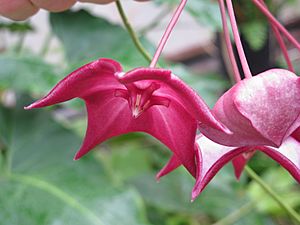Hoya macgillivrayi facts for kids
Quick facts for kids Hoya macgillivrayi |
|
|---|---|
 |
|
| Conservation status | |
|
Rare (NCA)
|
|
| Scientific classification | |
| Genus: |
Hoya
|
| Species: |
macgillivrayi
|
Hoya macgillivrayi is a beautiful, fast-growing climbing plant. It comes from northeastern Australia. This plant was first found in Queensland in the McIlwraith and Tozer Range. It was discovered by a person named Frederick Manson Bailey. The plant was named after William David Kerr Macgillivray. He helped collect the first official sample of the plant.
About the Hoya Macgillivrayi
What it Looks Like
This plant has oval-shaped leaves that come to a point. It grows by twisting and climbing around other plants or structures. The flowers are quite large, about 6 cm (2.4 inches) across. Their size, shape, and color can be a little different depending on the specific plant type.
The flowers grow in bunches called umbels. Each bunch has 6 to 10 flowers. They all connect to a central point. Each flower is a deep, dark burgundy color. It has five sepals, which are like small leaves protecting the bud. It also has five main petals. Inside the flower, the stamens (which hold pollen) are hidden.
After the flowers, the plant grows fruit. These fruits are long pods, about 25 cm (10 inches) long. Inside these pods are flat seeds. The wind helps to spread these seeds around. However, it takes a long time for these seeds to sprout and grow into new plants.
How to Grow It
If you want to grow Hoya macgillivrayi, it needs soil that drains water well. It likes to stay dry during the winter months. This plant also prefers to have its roots a bit crowded in its pot. This is called being "rootbound."
If you live in a cooler place, you might need to protect this plant. It can be grown indoors as a houseplant. This plant is listed as "Rare" on the 1997 IUCN Red List. This means it is not very common in nature.

